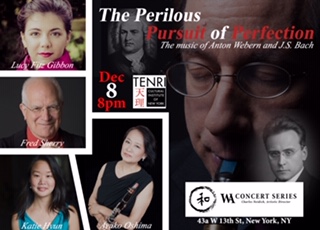Wa Concert Series presents “The Perilous Pursuit of Perfection: The Music of Anton Webern and J.S. Bach” in Review
Charles Neidich, Artistic Director, clarinet, basset horn; Ayako Oshima, clarinet, bass clarinet; Lucy Fitz Gibbon, soprano; Katie Hyun, violin; Fred Sherry, cello
Tenri Cultural Institute, New York, NY
December 8, 2019
Charles Neidich’s latest themed concert paired two masters of musical construction separated by two hundred years of music history: Anton Webern and J.S. Bach. No less fastidious a master than Maurice Ravel said (I paraphrase): “My goal is technical perfection. Since that is unattainable, I know that I may strive to come a little closer to it each day.”
Webern is one-third of the Schoenberg, Berg, Webern “Twelve-tone trinity,” which Schoenberg adamantly claimed was not a “method” (though it was, and it wasn’t even Schoenberg’s invention). Webern’s strength lies in his manipulation of timbre, allied with brevity that is sometimes carried to the extreme.
Webern’s Sechs Lieder nach Gedichten von Georg Trakl, Op. 14 (1917/21), set to six darkly expressionistic poems by fellow Austrian Georg Trakl, who died of a cocaine overdose three years before, feature Webern’s signature widely disjunct vocal lines that make text comprehension difficult. On that subject, soprano Lucy Fitz Gibbon gave a compelling performance, her voice even from top to bottom despite the wild demands placed on it, and I could even understand a large percentage of the words. The ensemble partnered her with sensitivity. I take issue with her textual analysis however: Trakl, a pharmacist whose mother was a drug addict, and who had incestuous relations with his own sister, distilled burning eroticism and menace into his work, not Catholic symbols.
Mr. Neidich then brought five of his own arrangements of Contrapuncti (I,IV, II, VII, IX) from Bach’s “last will and testament”: Die Kunst der Fuge, BWV 1080, a compendium of fugues all built from the same subject, displaying every possible combination of counterpoint, an anthology of the type that obsessed Bach late in his life, with the desire to summarize, teach, and leave a legacy. In the first group, Mr. Neidich refreshingly used the rarely heard autograph versions, which often lack the codas that were added later, by J.S. Bach, not his son, as claimed. The first eleven were actually put in order and prepared for publication in Bach’s lifetime, thought the first edition would have to wait until 1802.
Mr. Neidich’s engaging oral program notes failed to take into account one issue: Christoph Wolff and many other Bach scholars agree that in the case of the great “unfinished” quadruple fugue (heard at the end of the program), the final combinatorial section was figured out first, to make sure it was possible. Bach then went back and began writing it out from the beginning, and the music peters out right after the introduction of the musical spelling B-A-C-H (B-flat, A, C, B natural) as the third subject, where Bach’s son indicates that “he died.” This gave rise to centuries of romantic speculation about Bach’s “musical hubris” as a cause of his demise.
The contrapuncti were played with clarity, though the endings of two of them (VII and IX) were botched. I wished for slightly more articulation than the (mostly) legato that was applied.
After intermission, Ms. Fitz Gibbon returned with Webern’s own counterpoints, Fünf Canons, Op. 16 (1923/24), to Roman Catholic liturgical lines. They are canons in the sense of musical imitation, and also the religious sense. Mr. Neidich ought to have made the point that Bach’s Art of the Fugue also contains four canons, and that Webern himself arranged Bach’s fugues using his characteristic Klangfarbenmelodie (sound-color-melody), assigning a different instrument to each note of the theme(s).
Three of Webern’s canons concern the crucifixion, and the two instrumental strands and one vocal strand crisscross each other in symbolic fashion, with every possible permutation and breathtaking efficiency: different pitch levels, inversion, and retrograde. The lullaby for the infant Jesus was tender, though in Webern’s severe way. This was the finest performance of this rarity that one is likely ever to hear live.
The ensemble finished with four more Bach Contrapuncti (III, V, XI, XVIII). They negotiated a near-mishap in Contrapuntus XI, a devilishly complicated triple fugue, managing to find each other again with subtle skill.
This concert featured the “head” portion of what I call the “head/heart ratio,” though, as Bach scholar Wilfred Mellers states, what makes Bach’s music so expressive is his “keen understanding of human suffering reflected through his use of dissonance.” Webern’s music is highly expressive too, though one needs to be on his wavelength to perceive just how much passion he channeled into his art.
The final song from the Trakl series was offered as a true encore—the savvy audience that attends the WA series is not afraid of a little serialism- they applauded long and loud. The customary curated feast of food and drink was delicious as always. A word to the wise, this series has been and will continue to be one of New York’s most valuable gems—please support it.

